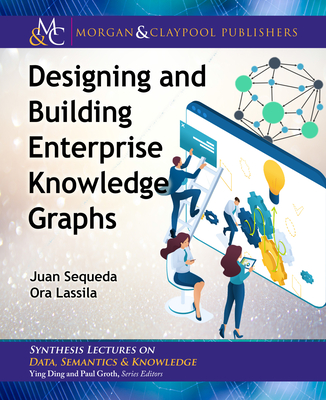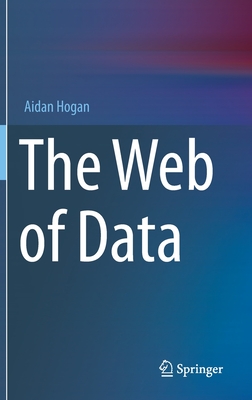Designing and Building Enterprise Knowledge Graphs
暫譯: 設計與建構企業知識圖譜
Juan Sequeda , Ora Lassila
- 出版商: Morgan & Claypool
- 出版日期: 2021-08-05
- 售價: $3,530
- 貴賓價: 9.5 折 $3,354
- 語言: 英文
- 頁數: 165
- 裝訂: Hardcover - also called cloth, retail trade, or trade
- ISBN: 1636391761
- ISBN-13: 9781636391762
海外代購書籍(需單獨結帳)
相關主題
商品描述
This book is a guide to designing and building knowledge graphs from enterprise relational databases in practice. It presents a principled framework centered on mapping patterns to connect relational databases with knowledge graphs, the roles within an organization responsible for the knowledge graph, and the process that combines data and people. The content of this book is applicable to knowledge graphs being built either with property graph or RDF graph technologies.
Knowledge graphs are fulfilling the vision of creating intelligent systems that integrate knowledge and data at large scale. Tech giants have adopted knowledge graphs for the foundation of next-generation enterprise data and metadata management, search, recommendation, analytics, intelligent agents, and more. We are now observing an increasing number of enterprises that seek to adopt knowledge graphs to develop a competitive edge.
In order for enterprises to design and build knowledge graphs, they need to understand the critical data stored in relational databases. How can enterprises successfully adopt knowledge graphs to integrate data and knowledge, without boiling the ocean? This book provides the answers.
商品描述(中文翻譯)
這本書是一本關於從企業關聯資料庫設計和建構知識圖譜的實用指南。它提出了一個以映射模式為中心的原則框架,旨在將關聯資料庫與知識圖譜連接起來,並說明組織內負責知識圖譜的角色,以及結合數據和人員的過程。本書的內容適用於使用屬性圖(property graph)或RDF圖技術建構的知識圖譜。
知識圖譜實現了創建智能系統的願景,這些系統能夠在大規模上整合知識和數據。科技巨頭已經採用知識圖譜作為下一代企業數據和元數據管理、搜索、推薦、分析、智能代理等的基礎。我們現在觀察到越來越多的企業尋求採用知識圖譜來發展競爭優勢。
為了讓企業設計和建構知識圖譜,他們需要了解存儲在關聯資料庫中的關鍵數據。企業如何能夠成功採用知識圖譜來整合數據和知識,而不必事無大小?這本書提供了答案。
作者簡介
Juan Sequeda is the Principal Scientist at data.world. He joined through the acquisition of Capsenta, a company he founded as a spin-off from his research. Juan's goal is to reliably create knowledge from inscrutable data. His academic and industry work has been on designing and building knowledge graphs for enterprise data integration where he has researched and developed technologies for semantic and graph data virtualization, ontology and graph data modeling and schema mapping, and data integration methodologies. Juan serves as a bridge between academia and industry through standardization committees, like serving as the co-chair of the Property Graph Schema Working Group and a past member of the Graph Query Languages task force of the Linked Data Benchmark Council (LDBC), as well as a past invited expert member and standards editor at the World Wide Web Consortium (W3C).
Juan holds a Ph.D. in Computer Science from The University of Texas at Austin. He is the recipient of the NSF Graduate Research Fellowship, 2nd place in the 2013 Semantic Web Challenge for his work on ConstituteProject.org, Best Student Research Paper at International Semantic Web Conference 2014, and the 2015 Best Transfer and Innovation Project awarded by the Institute for Applied Informatics.
Ora Lassila is a Principal Graph Technolgist in the Amazon Neptune graph database team. Earlier, he was a Managing Director at State Street, heading efforts to adopt ontologies and graph databases. Before that, he worked as a technology architect at Pegasystems, as an architect and technology strategist at Nokia Location & Commerce (later renamed HERE), and prior to that as a Research Fellow at the Nokia Research Center. He was an elected member of the Advisory Board of the World Wide Web Consortium (W3C) in 1998-2013, and represented Nokia in the W3C Advisory Committee in 1998-2002. In 1996-1997 he was a Visiting Scientist at MIT Laboratory for Computer Science, working with W3C and launching the Resource Description Framework (RDF) standard; he served as a co-editor of the original RDF Model and Syntax specification. Much of his research work at the Nokia Research Center focused on the Semantic Web and particularly its applications to mobile and ubiquitous computing. He collaborated with several U.S. universities, and was an active participant in the DARPA Agent Markup Language (DAML) program.
His positions before that include Project Manager at the Robotics Institute of Carnegie Mellon University and Research Scientist at the Computer Science Laboratory of Helsinki University of Technology. He has also worked as a software engineer in several companies (including his own start-up). He is the author of more than 100 conference papers and journal articles. He holds a Ph.D. in Computer Science from the Helsinki University of Technology (renamed Aalto University some years ago). Ora is the recipient of the Best Student Paper award of the 1989 Scandinavian Conference on AI, the Grand Prize of the 1989 Usenix Obfuscated C Code Contest, and the Semantic Web Science Association's 10-year award.
作者簡介(中文翻譯)
Juan Sequeda 是 data.world 的首席科學家。他通過收購他創立的公司 Capsenta 加入該公司,這是一家從他的研究中衍生出來的公司。Juan 的目標是從難以理解的數據中可靠地創造知識。他在學術界和業界的工作集中於設計和構建企業數據整合的知識圖譜,並在語義和圖數據虛擬化、本體和圖數據建模及模式映射、數據整合方法論方面進行了研究和技術開發。Juan 通過標準化委員會在學術界和業界之間架起橋樑,例如擔任屬性圖模式工作組的共同主席,以及曾任 Linked Data Benchmark Council (LDBC) 的圖查詢語言工作組成員,還曾擔任萬維網聯盟 (W3C) 的受邀專家成員和標準編輯。
Juan 擁有德克薩斯大學奧斯汀分校的計算機科學博士學位。他曾獲得 NSF 研究生研究獎學金、2013 年語義網挑戰賽的第二名(因其在 ConstituteProject.org 上的工作)、2014 年國際語義網會議的最佳學生研究論文獎,以及 2015 年由應用資訊學研究所頒發的最佳轉移與創新項目獎。
Ora Lassila 是亞馬遜 Neptune 圖數據庫團隊的首席圖技術專家。此前,他是 State Street 的董事總經理,負責推動本體和圖數據庫的採用。在此之前,他曾在 Pegasystems 擔任技術架構師,在 Nokia Location & Commerce(後來更名為 HERE)擔任架構師和技術策略師,並在 Nokia 研究中心擔任研究員。他在 1998-2013 年期間是萬維網聯盟 (W3C) 諮詢委員會的當選成員,並在 1998-2002 年期間代表 Nokia 參加 W3C 諮詢委員會。在 1996-1997 年,他是麻省理工學院計算機科學實驗室的訪問科學家,與 W3C 合作並啟動資源描述框架 (RDF) 標準;他曾擔任原始 RDF 模型和語法規範的共同編輯。他在 Nokia 研究中心的研究工作主要集中在語義網,特別是其在移動和無處不在計算中的應用。他與幾所美國大學合作,並積極參與 DARPA 代理標記語言 (DAML) 計劃。
在此之前,他的職位包括卡內基梅隆大學機器人研究所的項目經理和赫爾辛基科技大學計算機科學實驗室的研究科學家。他還曾在多家公司(包括他自己的初創公司)擔任軟件工程師。他是 100 多篇會議論文和期刊文章的作者。他擁有赫爾辛基科技大學(幾年前更名為阿爾托大學)的計算機科學博士學位。Ora 曾獲得 1989 年斯堪的納維亞人工智慧會議的最佳學生論文獎、1989 年 Usenix 混淆 C 代碼競賽的特別獎,以及語義網科學協會的 10 年獎。





















